Mises, Ludwig von. Human Action: A Treatise on Economics
Подождите немного. Документ загружается.

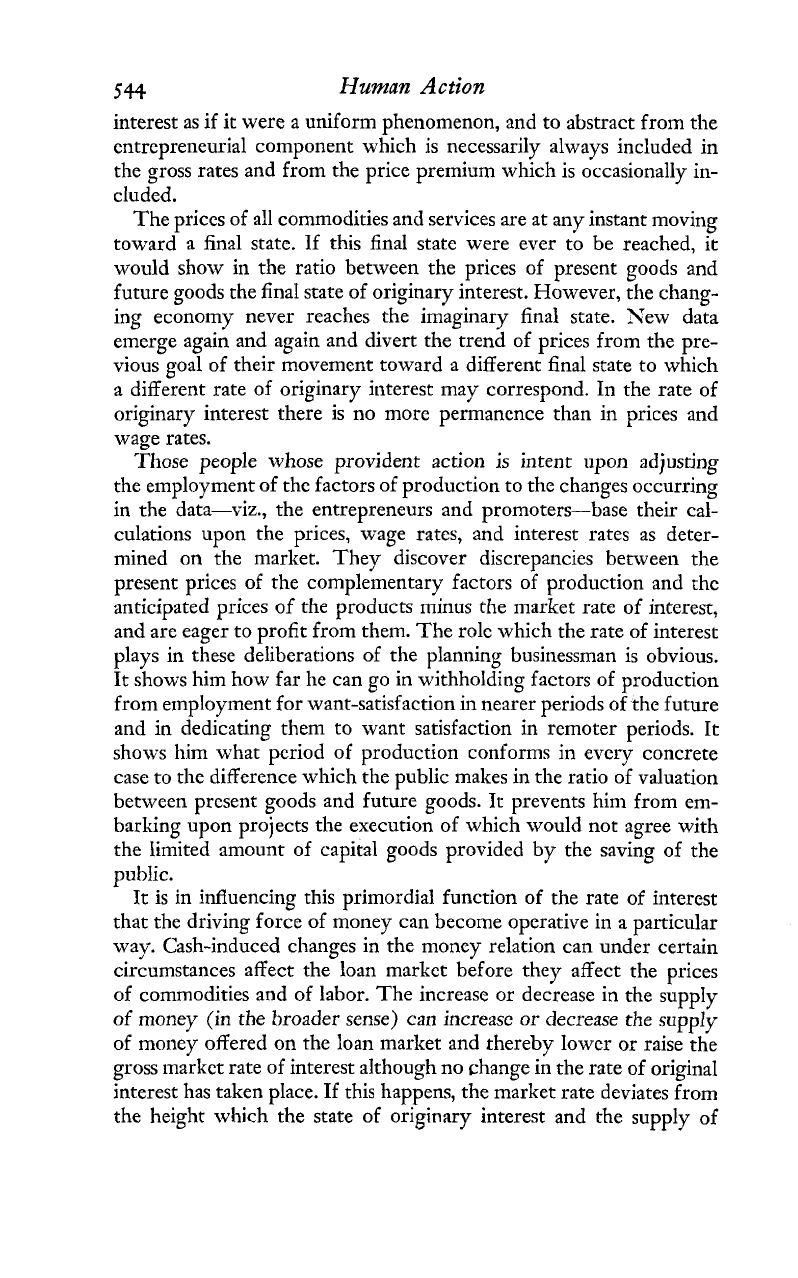
544
Human
Action
interest as if it were a uniform phenomenon, and to abstract from the
cntrcpreneurial component which is necessarily always included in
the gross rates and from the price premium which is occasionally in-
cluded.
The prices of all commodities and services are at any instant moving
toward a final state. If this final state were ever to be reached, it
would show in the ratio between the prices of present goods and
future goods the final state of originary interest. However, the chang-
ing economy never reaches the imaginary final state. Sew data
emerge again and again and divert the trend of prices from the pre-
vious goal of their movement toward a different final state to which
a different rate of originary interest may correspond. In the rate of
originary interest there is no more permanence than in prices and
wage rates.
TThose people whose provident action is intent upon adjusting
the employment of thc factors of production to the changes occurring
in the data-viz., the entrepreneurs and promoters-base their cal-
culations upon the prices, wage rates, and interest rates as deter-
mined on the market. They discover discrepancies between the
present prices of the complementary factors of production and the
anticipated prices of the products minus the market rate of interest,
and are eager to profit from them. The role which the rate of interest
plays in these deliberations of the planning businessman is obvious.
It shows him how far lie can go in withholding factors of production
from employment for want-satisfaction in nearer periods of the future
and in dedicating them to want satisfaction in remoter periods. It
shows
him
what period of production conforms in every concrete
case to the difference which the public makes in the ratio of valuation
between present goods and future goods. It prevents him from em-
barking upon projects the execution of which would not agree with
the limited amount of capital goods provided by the saving of the
public.
It
is in influencing this primordial function of the rate of interest
that the driving force of money can become operative in a particular
way. Cash-induced changes in the money relation can under certain
circumstances affect the loan market before they affect the prices
of commodities and of labor. The increase or decrcase in the supply
of money (in the broader sense) can increase or decrease
the
supply
of money offered on the loan market and thereby lower or raise the
gross market rate of interest although no change in the rate of original
interest has taken place. If this happens, the market rate deviates from
the height which the state of originary interest and the supply of
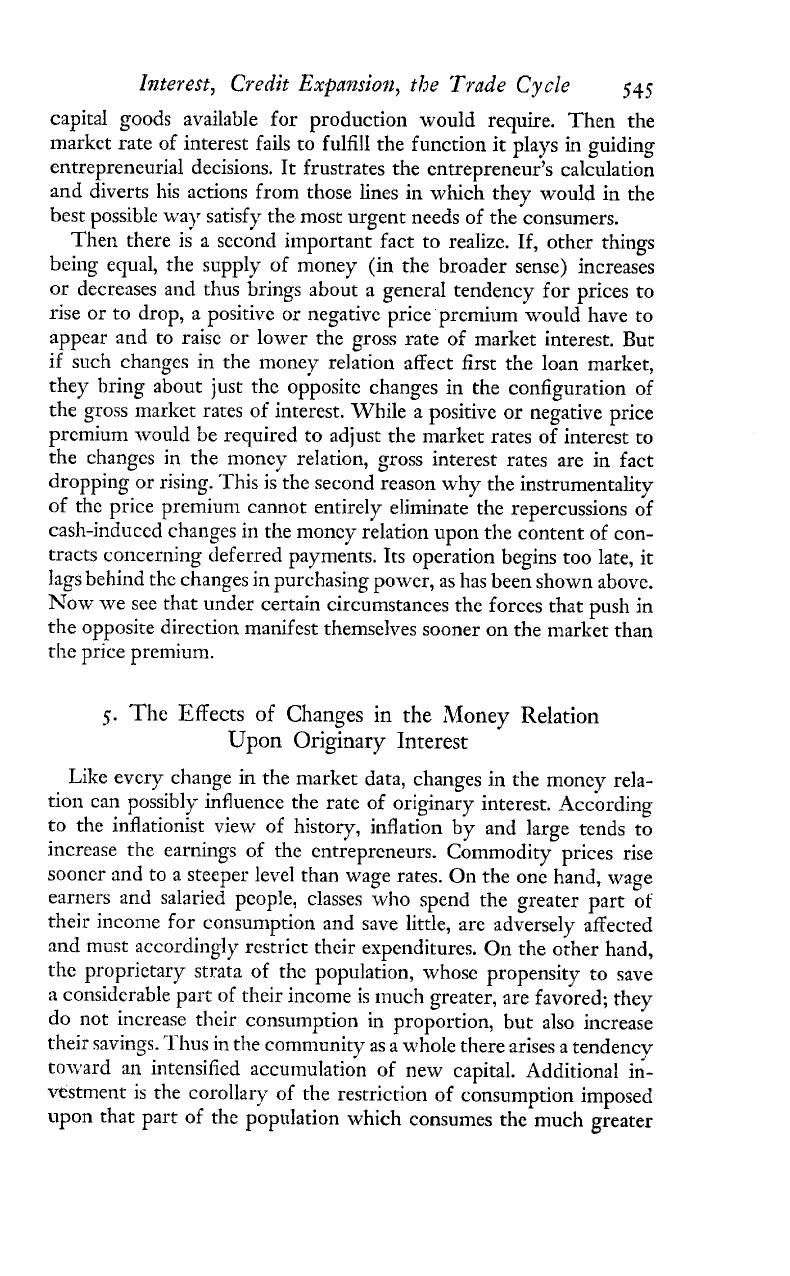
Interest, Credit
Expansio~~,
the
Trade
Cycle
545
capital goods available for production would require. Then the
market rate of interest fails to fulfill the function it plays in guiding
entrepreneurial decisions. It frustrates the entrepreneur's calculation
and diverts his actions from those lines in which they would in the
best possible way satisfy the most urgent needs of the consumers.
Then there is
a
second important fact to realize. If, other things
being equal, the supply of money (in the broader sense) increases
or decreases and thus brings about a general tendency for prices to
rise or to drop,
a
positive or negative price prcmium would have to
appear and to raisc or lower the gross rate of market interest. But
if such changes in the money relation affect first the loan market,
they bring about just the opposite changes in the configuration of
the gross market rates of interest. While a positive or negative price
premium would be required to adjust the market rates of interest to
the changes in the money relation, gross interest rates are in fact
dropping or rising. 'This is the second reason why the instrumentality
of the price premium cannot entirely eliminate the repercussions of
cash-induced changes in the money relation upon the content of con-
tracts concerning deferred payments. Its operation begins too late, it
lags behind the changes in purchasing power, as has been shown above.
Now we see that under certain circumstances the forces that push in
the opposite direction manifest themselves sooner on the market than
the price premium.
5.
The Effects
of
Changes in the Money Relation
Upon Originary Interest
Like every change in the market data, changes in the money rela-
tion can possibly influence the rate of originary interest. -4ccording
to the inflationist view of history, inflation by and large tends to
increase the earnings of the entrepreneurs. Commodity prices rise
sooner and to a steeper level than wage rates. On the one hand, wage
earners and salaried peopie, ciasses who spend the greater part of
their income for consumption and save little, are adversely affected
and must accordingly restrict their expenditures. On the other hand,
the
proprietary strata of the population, whose propensity to save
a considerable part
of
their income is much greater, are favored; they
do not increase their consumption in proportion, but also increase
their savings. Thus in the community as
a
whole there arises a tendency
toxvard an intensified accumulation of new capital. Additional in-
vestment is the corollary of the restriction of consumption imposed
upon that part of the population which consumes the much greater

546
Human
Action
part of the annual produce of the economic system. This
forced
saving
lowers the rate of originary interest. It accclcrates the pace of
economic progress and the improvement in technological methods.
It is important to realize that such forced saving can originate from
an inflationary movement and actually often did so originate in the
past. In dealing with the effects of changes in the money relation upon
the height of interest rates, one must not neglect the fact that such
changes can under certain circumstances rcally alter the rate of
originary interest. But several other facts must be taken into account,
too.
First one must realize that forced saving can result from inflation,
but need not necessarily. It depends on thc particular data of each
instance of inflation whether or not the rise in wage ratcs lags behind
the rise in commodity prices.
A
tendency for real wage rates to drop
is not an inescapable consequence of a decline in the monetary unit's
purchasing power. It could happen that nominal wage rates rise
more than or sooner than commodity pricesn4
Furthermore, it is necessary to remember that the greater propen-
sity of the wealthier classes to save and to accumulate capital is merely
a
psychological and not a praxeological fact. It could happen that
these pcople to whom the inflationary movcrnent conveys additional
proceeds do not save and invest their boon but employ it for an in-
crease
in their consumption. It is impossible to predict with the
apodictic definiteness which characterizes all theorems of economics,
in what way those profiting from the inflation will act. History can
tell us what happened in the past. But it cannot assert that it must
happen in the future.
It w-ould be
3
serious blunder to neglect the fact that inflation also
generates forces which tend toward capital consumption. One of its
consequences is that it falsifies cconomic calculation and accounting.
It produces the phenomenon of imaginary or apparent profits.
If
the
annual depreciation quotas are determined in such a way as not to
pay full regard to the fact that the replacement of worn-out equip-
ment will require higher costs than the amount for which it was pur-
chased in the past, they are obviously insufficient. If in selling inven-
tories and products the whole difference bctween the price spent for
their acquisition and the price realized in the sale is entered in the
books as a surplus, the error is the same. If the rise in the prices of
stocks and real estate is considered as a gain, the illusion is no less
manifest. What makes people believe that inflation results in general
4.
We are dealing here with conditions on an unhampered labor market. About
the argument advanced by Lord Keynes, see below,
pp.
771 and 786-787.
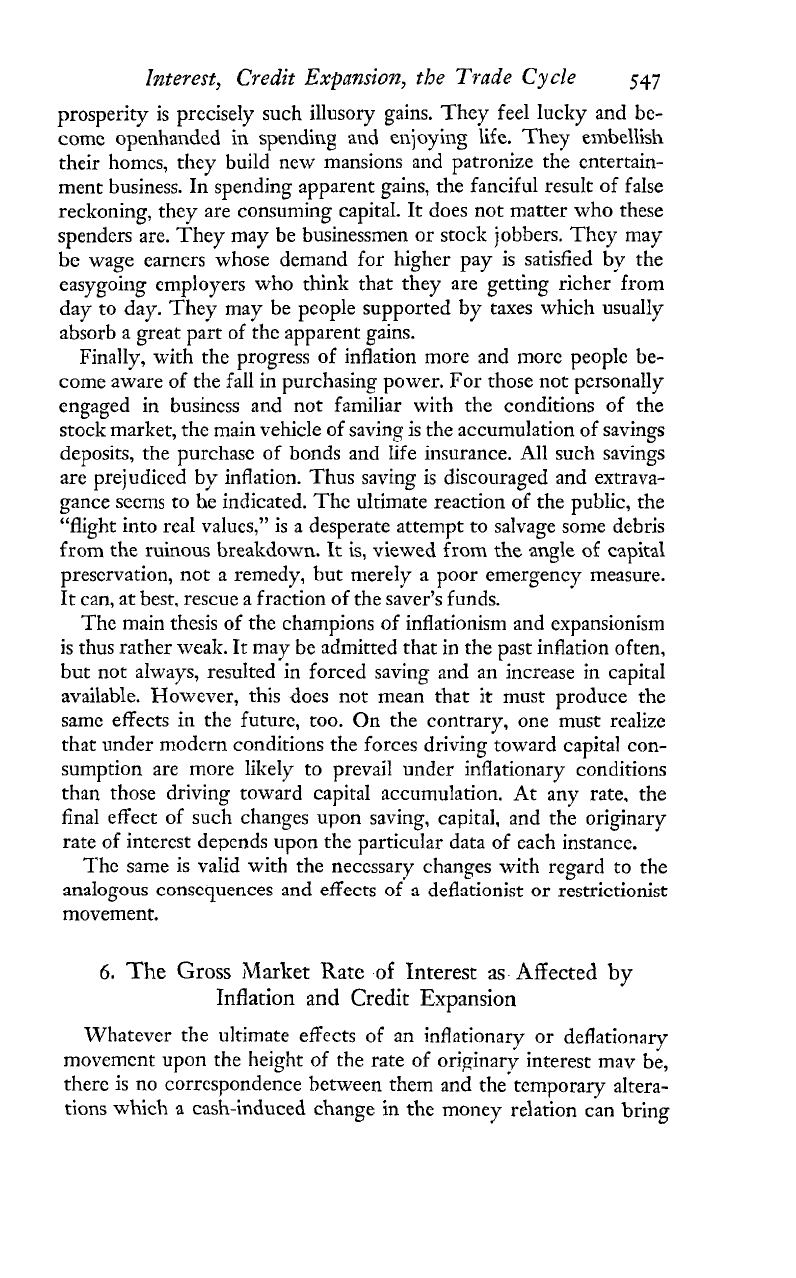
Interest, Credit Expansion, the Trade Cycle
547
prosperity is prccisely such illusory gains. They feel lucky and be-
come openhanded
in
spending and enjoying
life.
They embellish
their homcs, they build new mansions and patronize the cntertain-
ment business. In spending apparent gains, the fanciful result of false
reckoning, they are consun~ing capital. It does not matter who these
spenders are. They may be businessmen or stock jobbers. Thcy may
bc wage earncrs whose demand for higher pay is satisfied by the
easygoing employers who think that they are getting richer from
day to day. They may be people supported by taxes which usually
absorb a great part of thc apparent gains.
Finally, with the progress of inflation more and morc peoplc be-
come aware of the fall in purchasing power. For those not personally
engaged in busincss and not familiar with the conditions of the
stock market, thc main vehicle of saving is the accumulation of savings
deposits, the purchase of bonds and life insurance. All such savings
are prejudiccd by inflation. Thus saving is discouraged and extrava-
gance sccms to he indicated. The ultimate reaction of the public, the
"flight into real values," is a desperate attempt to salvage some debris
from the ruinous breakdown.
It
is,
viewed
from the angle of capital
prescrvation, not a remedy, but merely a poor emergency measure.
It can, at best. rescue a fraction of the saver's funds.
The main thesis of thc champions of inflationism and cxpansionism
is thus rather weak. It may be admitted that in the past inflation often,
but not always, resuIted in forced saving and an increase in capital
available. However, this does not mean that
it
must produce the
same effects in the futurc, too. On the contrary, one must rcalize
that under modcrn conditions the forces driving toward capital con-
sumption are more likely to prevail under inflationary conditions
than those driving toward capital accumulation. At any rate, the
final effect of such changes upon saving, capital. and the originary
rate of intcrcst depends upon the particulzr data of each instance.
The same is valid with the
necessary
changes with regard to the
analogous conscquences and effccts of' a deflationist or restrictionist
movement.
6.
The Gross Market Ratc of Interest as- Affected
by
Inflation
and
Credit Expansion
Whatcver the ultimate effects of an inflationary or deflationary
movement upon the height of the rate of originarv interest mav be,
therc is no correspondence between them and the'tcmporary altera-
tions which a cash-induced change in the money relation can bring
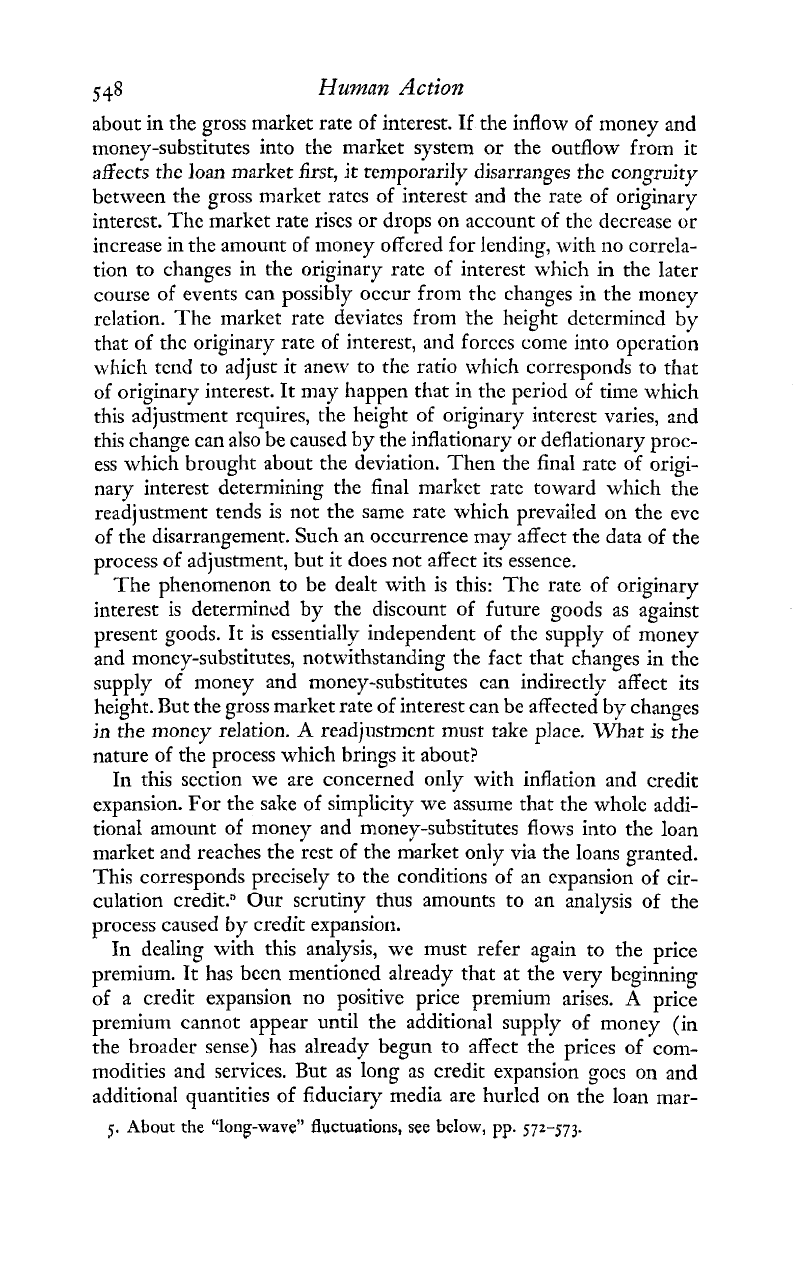
54s
Human
Action
about in the gross market rate of interest. If the inflow of money and
money-substitutes into the market system or the outflow from it
affects the loan market first, jt remporarily disarranges the congruity
between the gross market rates of intercst and the rate of originary
intercst. The market rate rises or drops on account of thc decrease or
increase in the amount of money offcred for lending, with no correla-
tion to changes in the originary rate of interest which in the later
course of events can possibly occur from thc changes in the money
relation. The market rate deviates from the height dctermincd by
that of the originary ratc of interest, and forces come into operation
which tend to adjust it anew to the ratio which corresponds to that
of originary interest. It may happen that in the period of time which
this adjustment
requires,
the height of originary intcrcst varies, and
this change can also be caused by the inflationary or deflationary proc-
ess which brought about the deviation. Then the final ratc of origi-
nary interest determining the final marlcct rate toward which the
readjustment tends is not the same rate which prevaiIed on the eve
of the disarrangement. Such an occurrence may affect the data of the
process of adjustment, but it does not affect its essence.
The phenomenon to be dealt with is this: The rate of originary
interest is determined by the discount of future goods as against
present goods. It is essentially independent of the supply of money
and money-substitutes, notwithstanding the fact that changes in the
supply of money and money-substitutes can indirectly affect its
height. But the gross market rate of interest can be affected by changes
jn
the money relation.
A
readjustment must take place. What is the
nature of the process which brings it about?
In this section we are concerned only with inflation and credit
expansion. For the sake of simplicity we assume that the whole addi-
tional amount of money and money-substitutes flows into the loan
market and reaches the rest of the market only via the loans granted.
This corresponds precisely to the conditions of an expansion of cir-
culation credit.Wur scrutiny thus amounts to an analysis of the
process caused by credit expansion.
In dealing with this analysis,
we
must refer again to the price
premium. It has been mentioned already that at the very begillning
of a credit expansion no positive price premium arises.
A
price
premium cannot appear until the additional supply of money (in
the broader sense) has already begun to affect the prices of com-
modities and services. But as long as credit expansion goes on and
additional quantities of fiduciary media are hurled on the loan mar-
s.
About
the
"long-wave" fluctuations,
see
below,
pp.
572-273.
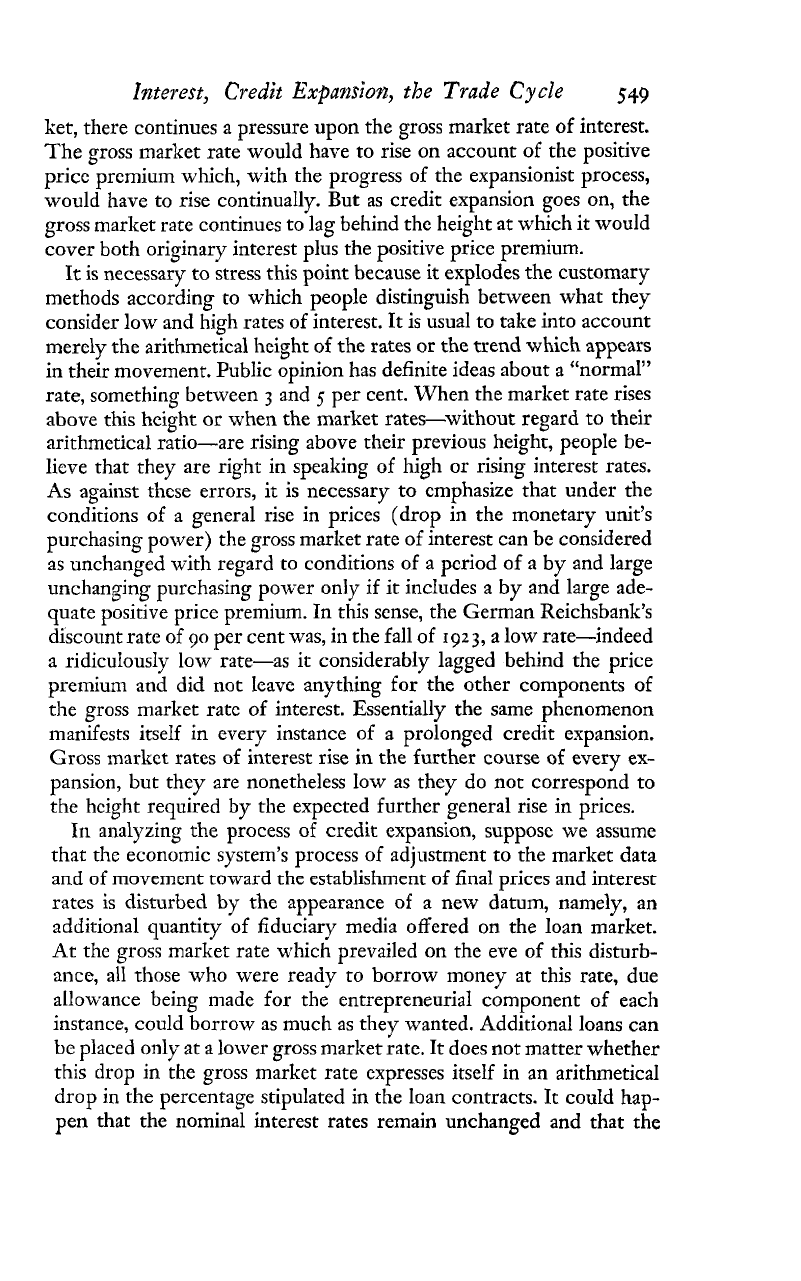
Interest, Credit Expansion, the Trade Cycle
549
ket, there continues a pressure upon the gross market rate of interest.
The gross market rate would have to rise on account of the positive
price premium which, with the progress of the expansionist process,
would have to rise continually. But as credit expansion goes on, the
gross market rate continues to lag behind the height at which it would
cover both originary interest plus the positive price premium.
It:
is necessary to stress this point because it explodes the customary
methods according to which people distinguish benveen what they
consider low and high rates of interest. It is usual to take into account
merely the arithmetical height of the rates or the trend which appears
in their movement. Public opinion has definite ideas about a "normal"
rate, something between
3
and
5
per cent. When the market rate rises
above this hcight or when the market rates-without regard to their
arithmetical ratio-are rising above their previous height, people be-
lieve that they are right in speaking of high or rising interest rates.
As against these errors,
it
is necessary to emphasize that under the
conditions of a general rise in prices (drop in the monetary unit's
purchasing power) the gross market rate of interest can be considered
as unchanged w-ith regard to conditions of a period of a by and large
unchanging purchasing power only if it includes a by and large ade-
quate positive price premium. In this sense, the German Reichsbank's
discount rate of
go
per cent was, in the fall of 1923, a low rate-indeed
a ridiculously low rate-as it considerably lagged behind the price
premium and did not leave anything for the other components of
the gross market rate of interest. Essentially the same phenomenon
manifests itseIf in every instance of a prolonged credit expansion.
Gross market rates of interest rise in the further course of every ex-
pansion, but they are nonetheless low as they do not correspond to
the hcight required by the expected further general rise in prices.
In analyzing the process of credit expansion, suppose we assume
that the economic system's process of adjustment to the market data
and of movement toward the establishment of final prices and interest
rates is disturbed
by
the appearance of a new datum, namely, an
additional quantity of fiduciary media offered on the loan market.
At
the gross market rate which prevailed on the eve of this disturb-
ance, all those who were ready to borrow money at this rate, due
allowance being made for the entrepreneurial component of each
instance, could borrow as much as they wanted. Additional loans can
be placed only at a lower gross market rate. It does not matter whether
this drop in the gross market rate expresses itself in an arithmetical
drop in the percentage stipulated in the loan contracts. It could hap-
pen that the nominal interest rates remain unchanged and that the
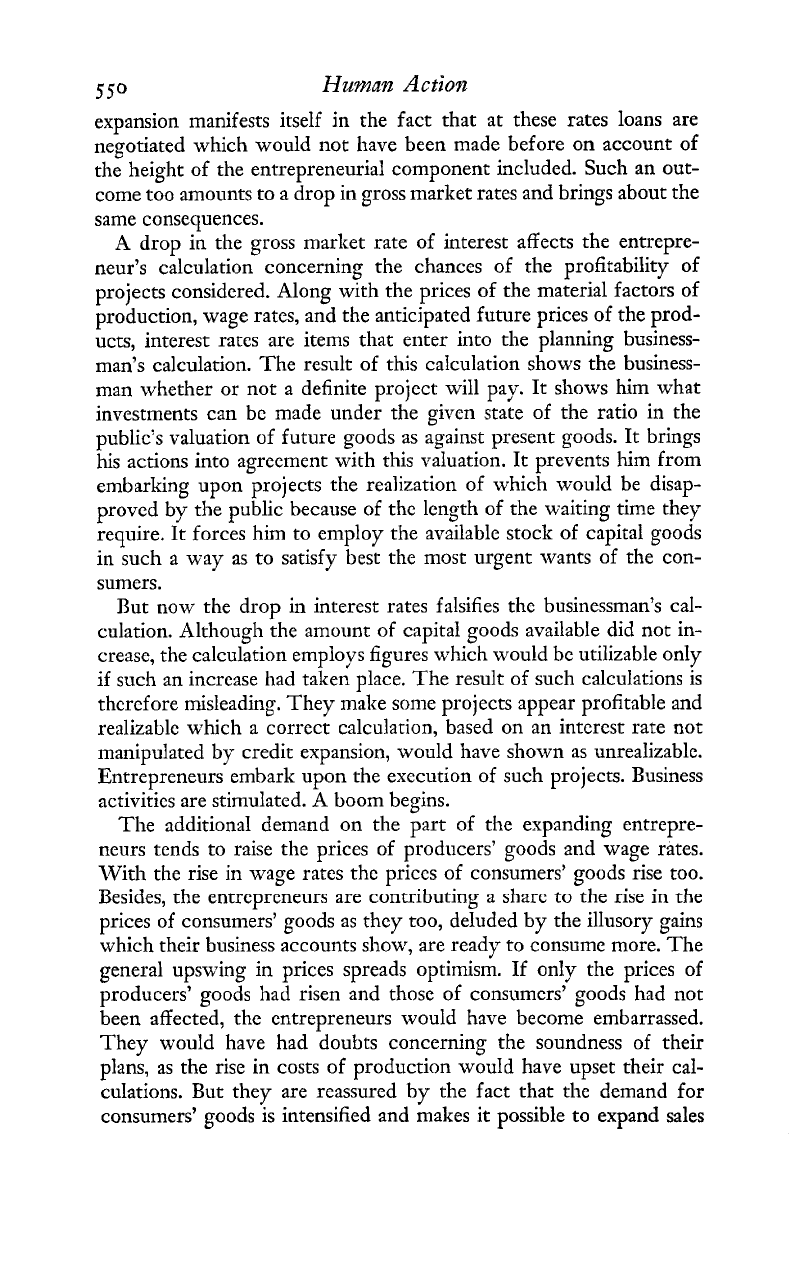
5
50
Human
Action
expansion manifests itself in the fact that at these rates loans are
negotiated which would not have been made before on account of
the height of the entrepreneurial component included. Such an out-
come too amounts to a drop in gross market rates and brings about the
same consequences.
A drop in the gross market rate of interest affects the entrepre-
neur's calculation concerning the chances of the profitability of
projects considered. Along with the prices of the material factors of
production, wage rates, and the anticipated future prices of the prod-
ucts, interest rates are items that enter into the planning business-
man's calculation. The result of this calculation shows the business-
man whether or not a definite project will pay. It shows him what
investments can bc made under the given state of the ratio in the
public's valuation of future goods as against present goods. It brings
his actions into agreement with this valuation. It prevents him from
embarking upon projects the realization of which would be disap-
proved
by the public because of the length of the waiting time they
require. It forces him to employ the available stock of capital goods
in such a way as to satisfy best the most urgent wants of the con-
sumcrs.
nut now the drop in interest rates falsifies the businessman's cal-
culation. Although the amount of capital goods available did not in-
crease, the calculation employs figures which would be utilizable only
if such an increase had taken place. The result of such calculations is
thcrcfore misleading. They make some projects appear profitable and
realizable which a correct calculation, based on an interest rate not
manipulated by credit expansion, would have shown as unrealizable.
Entrepreneurs embark upon the execution of such projects. Business
activities are stimulated.
A
boom begins.
The additional demand on the part of the expanding entrepre-
neurs tends to raise the prices of producers' goods and wage rates.
With the rise in wage rates the prices of consumers' goods rise too.
Besides, [he enucpreneurs are contributing a share
to
the rise in he
prices of consumers' goods as they too, deluded by the illusory gains
which their business accounts show, are ready to consume more. The
general upswing in prices spreads optimism. If only the prices of
producers' goods had risen and those of consumcrs' goods had not
been affected, the entrepreneurs would have become embarrassed.
They would have had doubts concerning the soundness of their
plans, as the rise in costs of production would have upset their cal-
culations. But they are reassured by the fact that the demand for
consumers' goods is intensified and makes it possible to expand sales
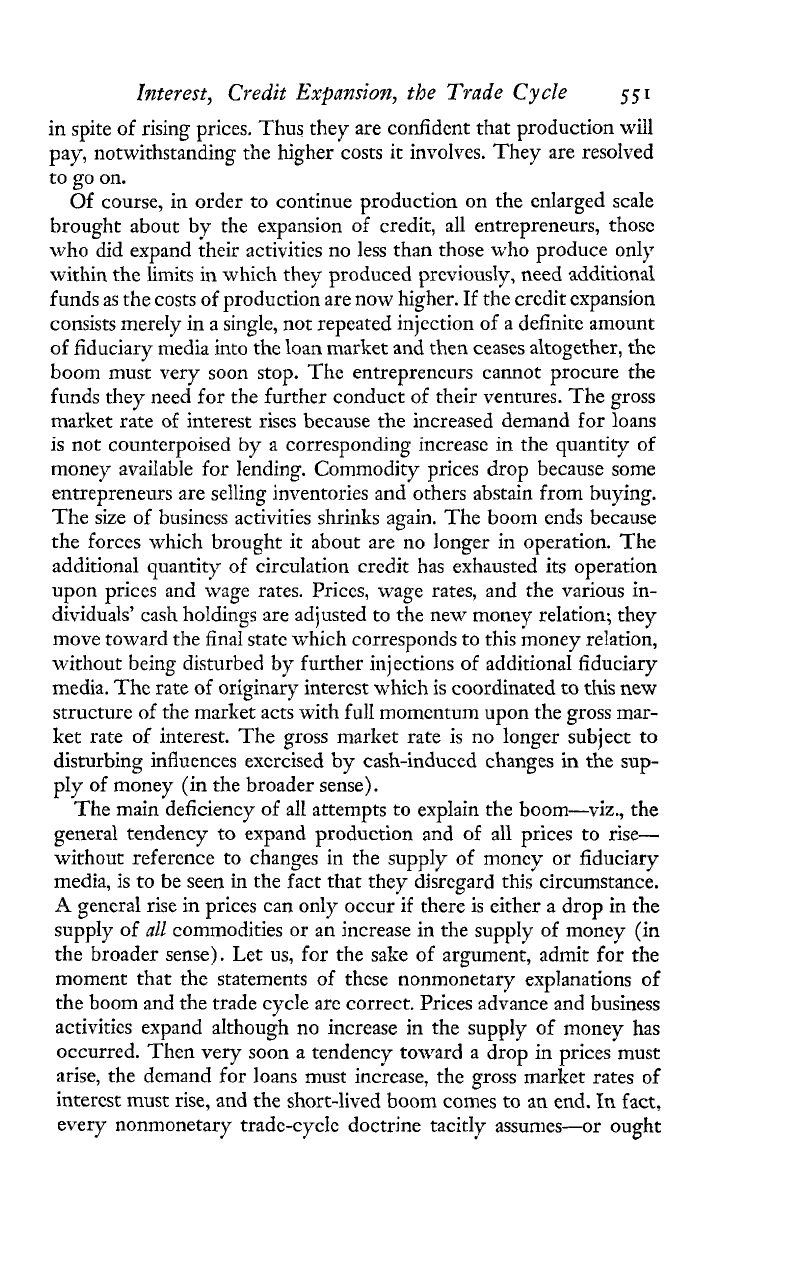
Interest, Csedit Expansion, the Trade
Cycle
55
I
in spite of rising prices, Thus they are confident that production will
pay, notwithstanding the higher costs it involves. They are resolved
to go on.
Of
course, in order to continue production on the enlarged scale
brought about by the expansion of credit, all entrepreneurs, those
who did expand ;heir activities no less than those who produce only
within the limits in which they produced previously, need additional
funds as the costs of production are now higher. If the credit expansion
consists merely in a single, not repeated injection of a definite amount
of fiduciary media into the loan market and then ceases altogether, the
boom must very soon stop. The entrepreneurs cannot procure the
funds they need for the further conduct of their ventures. The gross
market rate of interest rises because the increased demand for loans
is not counterpoised by a corresponding increase in the quantity of
money available for lending. Commodity prices drop because some
entrepreneurs are selling inventories and others abstain from buying.
The size of business activities shrinks again. The boom ends because
the forces which brought it about are no longer in operation. The
additional quantity of circulation credit has exhausted its operation
upon prices and wage rates. Prices, wage rates, and the various in-
dividuals' cash hoIdings are adjusted to the new money relation; they
move toward the final state which corresponds to this honey relation,
without being disturbed by further injections of additional fiduciary
media. The rate of interest which is coordinated
to
this new
structure
of
the market acts with fulI momentum upon the gross mar-
ket rate of interest. The gross market rate is no longer subject to
disturbing influences exercised by cash-induced changes in the sup-
ply of money (in the broader sense).
The main deficiency of all attempts to explain the boom-viz., the
general tendency to expand production and of all prices to rise-
without reference to changes in the supply of money or fiduciary
media, is to be seen in the fact that they disregard this circumstance.
A
general rise in prices can only occur
if
there is either a drop in the
supply of
all
commodities or an increase in the supply of money (in
the broader sense). Let us, for the sake of arprnen;, admit for the
moment that the statements of these nonmonetary explanations of
the boom and the trade cycle are correct. Prices advance and business
activities expand although no increase in the supply of money has
occurred. Then very soon a tendency toward a drop in prices must
arise, the demand for loans must increase, the gross market rates of
interest must rise, and the short-lived boom comes to an end.
In
fact,
every nonmonetary trade-cycle doctrine tacitly assurnes-or ought
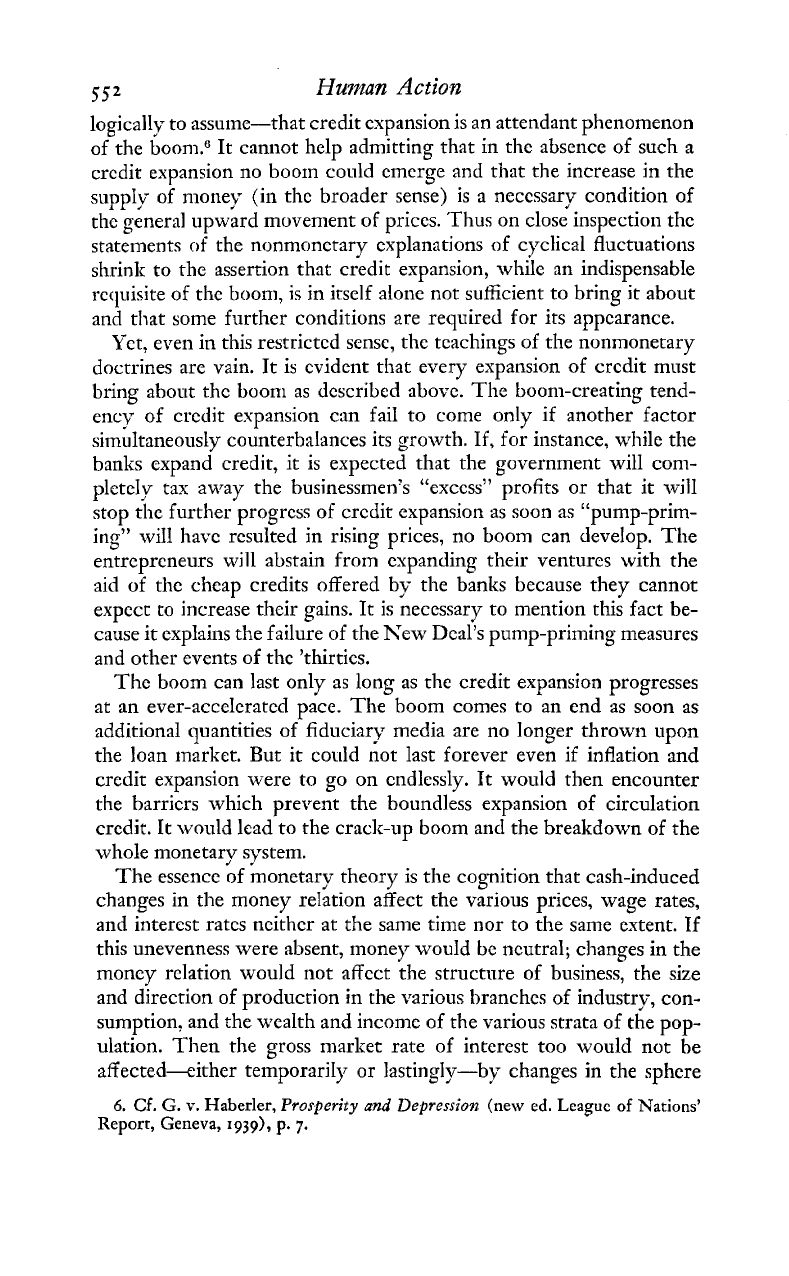
552
Human Action
logically to assume-that credit expansion is an attendant phenomenon
of the
boon^.^
It cannot help admitting that in the absence of such
a
crcdit expansion no boo~n could cmcrge and that the increase in the
supply of money (in the broader sense) is a neccssary condition of
thc general upward movement of prices. 'Thus on close inspection the
statements of the nonmonetary explanations of cyclical fluctuations
shrink to the assertion that credit expansion, while an indispensable
requisite of the boom, is in irself alone not sufficient to bring
it
about
and that some further conditions are required for its appearance.
Yet, even in this restricted sense, the tcachings of the nonmonetary
doctrines are vain. It is cvident that every expansion of crcdit must
bring about thc boom as dcscribed above. The boom-creating tend-
ency of crcdit expansion can fail to come only if another factor
simultaneously counterbalances its growth. If, for instance, u+ile the
banks cxpand credit, it is expected that the government will com-
pleteIy tax away the businessmen's "exccss" profits or that it will
stop the further progrcss of crcdit expansion as soon as "pump-prim-
ing" will havc resulted in rising prices, no boom can develop. The
entrcprcneurs will abstain from expanding their venturcs with the
aid of the cheap credits offered by the banks because they cannot
expect to increase thcir gains. It is necessary to mention this fact be-
cause it explains the failure of the
New
Dcal's pump-priming measures
and other events of the 'thirties.
The boom can last only as long as the credit expansion progresses
at an ever-acccleratcd pace. The boom comes to an end as soon as
additional quantities of fiduciary media are no longer thrown upon
the loan markct. But it could iot last forever even if inflation and
credit expansion were to go on cndlessly. It would then encounter
the barricrs which prevent the boundless expansion of circulation
crcdjr. It would lead to the crack-up boom and the breakdown of the
whole monetary system.
The essence of monetary theory is the cognition that cash-induced
changes in the money reiation affect the various prices, wage rates,
and intercst ratcs neither at the same time nor to the same extent. If
this unevenness were absent, money would bc ncutral; changes in the
moncy relation would not affect the structure of business, the size
and direction of production in the various branchcs of industry, con-
sumption, and the wealth and income of the various strata of the pop-
ulation. Then
the
gross market rate of interest too would not be
affected+ither temporariIy or lastingly-by changes in the sphere
6.
Cf.
G.
v.
Haberler,
Prosperity
and
Depression
(new
ed.
League
of
Nations'
Report,
Geneva,
1939)~
p.
7.
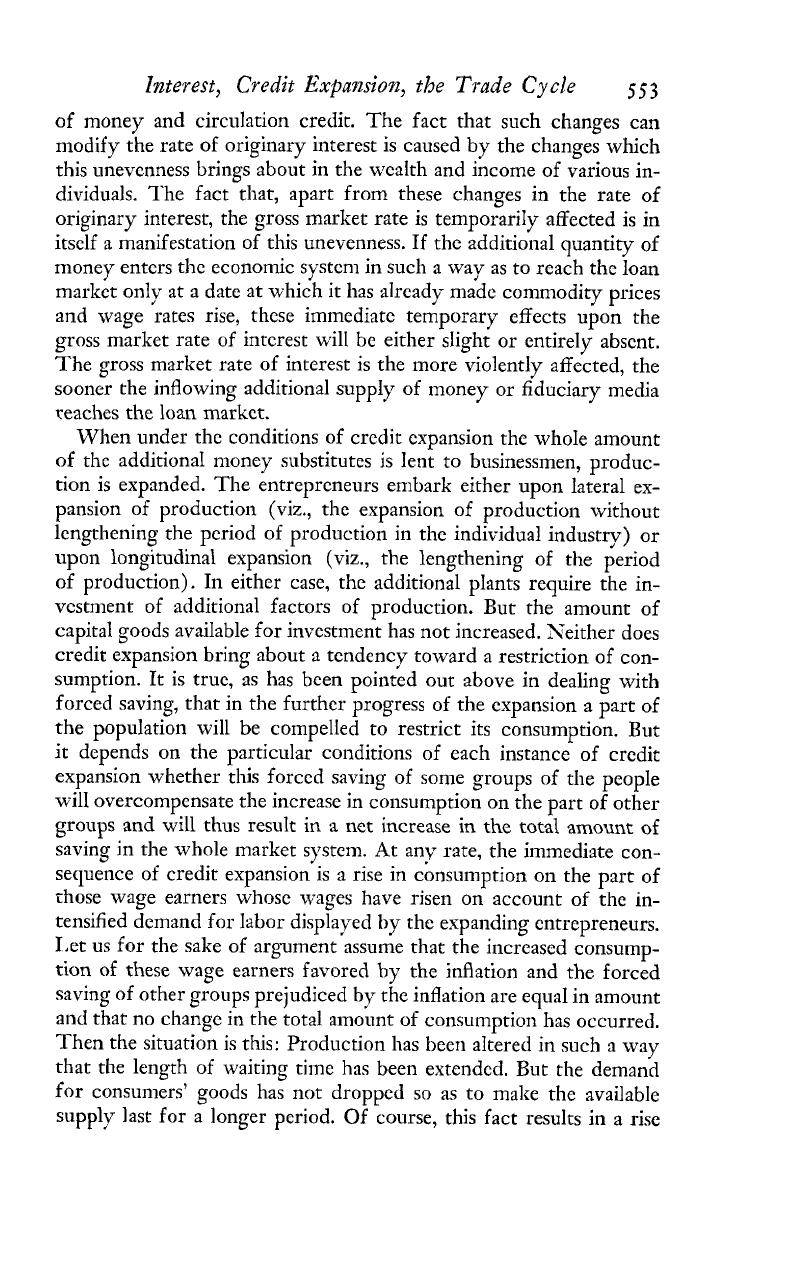
Interest, Credit Expansion, the Tmde Cycle
553
of money and circulation credit. The fact that such changes can
nlodifv the rate of originary interest is caused by the changes which
this unevenness brings about in the wealth and income of various in-
dividuals. The fact that, apart from these changes in the rate of
originary interest, the gross market rate is temporariIy affected is in
itself a manifestation of this unevenness. If the additional quantity of
money enters the economic system in such a way as to reach the loan
market only at a date at which it has already made commodity prices
and wage rates rise, these immediate temporary effects upon the
gross market rate of interest will be either slight or entirely absent.
The gross market rate of interest is the more violently affected, the
sooner the inflowing additional supply of money or fiduciary media
yeaches
the loan market.
When under the conditions of credit expansion the whole amount
of the additionaI money substitutes is lent to businessmen, produc-
tion is expanded. The entrepreneurs embark either upon lateral ex-
pansion of production (viz., the expansion of production without
lengthening the period of production in the individual industry) or
upon longitudinal expansion (viz., the lengthening of the period
of production). In either case, the additional plants require the in-
vestment of additional factors of production.
But
the amount of
capital goods available for investment has not increased. Neither does
credit expansion bring about a tendency toward a restriction of con-
sumption. It is true, as has been pointed out above in dealing with
forced saving, that in the further progress of the expansion a part of
the population will be compelled to restrict its consuinption. But
it depends on the particular conditions of each instance of credit
expansion whether this forced saving of some groups of the people
will overcompensate the increase in consumption on the part of other
groups and will thus result
in
a net increase
in
the total amount
of
saving in the whole market system. At any rate, the immediate con-
sequence of credit expansion is a rise in cbnsumption on the part of
those wage earners whose wages have risen on account of the in-
tensified demand for labor displayed by the expanding entrepreneurs.
Ixt
US
for the sake of argument assume that the increased consump-
tion
of
these wage earners favored
by
the inflation and the forced
saving of other groups prejudiced
by
the inflation are equal in amount
and
that no change in the total amount of consumption has occurred.
Then the situation is this: Production has been altered in such a way
that the length of waiting time has been extended. But the demand
for consunlers' goods has not dropped so as to make the available
supplv last for a longer period. Of course, this fact results in a rise
